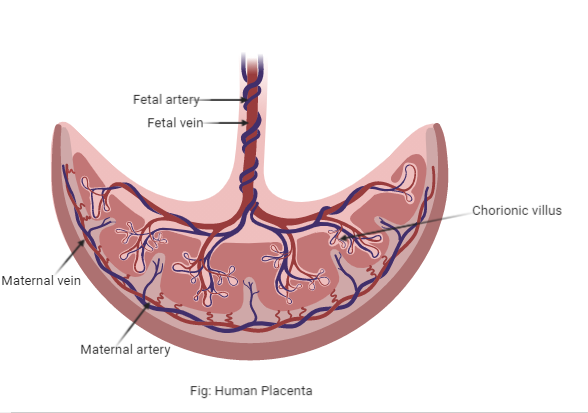Answer
401.7k+ views
Hint: After implantation, finger-like projection can be seen on the trophoblast and chorionic villi that are enclosed by the female internal reproductive organs which is the uterine tissue and maternal blood. The chorionic villi along with the uterine tissue become interdigitated with one another and form a ‘Placenta ‘between the developing embryo and maternal blood. The placenta supplies food to the growing fetus.
Complete step by step answer: The placenta is a cushion-like structure which acts as an endocrine tissue and produces several hormones such as human chorionic gonadotropin, human placental lactogen, estrogens, progesterone, and relaxin hormone.

Let us look at all the options to get the appropriate answer,
-Facilitates the supply of oxygen and nutrients to the embryo: Placenta is also responsible for the process of excretion and this is a function of the placenta.
-Secretes estrogen: Several hormones are secreted by the placenta and estrogen is one in each of them.
-Facilitates removal of carbon dioxide and waste material from embryos: the placenta is employed to produce nutrients to embryos and helps in gas exchange. It’s a function performed by the placenta. -Secretes oxytocin during parturition: placenta secretes innumerable hormones to nourish embryos however it doesn’t secrete the hormone oxytocin that is employed for delivery of babies.
So, the correct option is D- 'Secretes oxytocin during parturition'.
Note: Placenta doesn’t secrete Pitocin rather it secretes relaxin for softening the animal tissue of pubic symphysis throughout the process of parturition. The placenta acts as a secretor and synthesizes massive quantities of proteins and a few hormones like human sac gonadotropins, sac thyrotropic hormone, estrogens, and progestogen. The metabolic activity of the placenta is nearly equal to that of the fetus.
Complete step by step answer: The placenta is a cushion-like structure which acts as an endocrine tissue and produces several hormones such as human chorionic gonadotropin, human placental lactogen, estrogens, progesterone, and relaxin hormone.

Let us look at all the options to get the appropriate answer,
-Facilitates the supply of oxygen and nutrients to the embryo: Placenta is also responsible for the process of excretion and this is a function of the placenta.
-Secretes estrogen: Several hormones are secreted by the placenta and estrogen is one in each of them.
-Facilitates removal of carbon dioxide and waste material from embryos: the placenta is employed to produce nutrients to embryos and helps in gas exchange. It’s a function performed by the placenta. -Secretes oxytocin during parturition: placenta secretes innumerable hormones to nourish embryos however it doesn’t secrete the hormone oxytocin that is employed for delivery of babies.
So, the correct option is D- 'Secretes oxytocin during parturition'.
Note: Placenta doesn’t secrete Pitocin rather it secretes relaxin for softening the animal tissue of pubic symphysis throughout the process of parturition. The placenta acts as a secretor and synthesizes massive quantities of proteins and a few hormones like human sac gonadotropins, sac thyrotropic hormone, estrogens, and progestogen. The metabolic activity of the placenta is nearly equal to that of the fetus.
Recently Updated Pages
The deliquescent among the following is ACaCl2 BFeSO47H2O class 11 chemistry CBSE

The d electron configurations of Cr2 + Mn2 + Fe2 + class 11 chemistry CBSE

The degree of ionization of a 01M bromoacetic acid class 11 chemistry CBSE

The degree of Hydrolysis of CH3COONH4 is independent class 11 chemistry CBSE

The degree of hydrolysis for a salt of strong acid class 11 chemistry CBSE

The degree of hydrolysis for a salt of strong acid class 11 chemistry CBSE

Trending doubts
Which are the Top 10 Largest Countries of the World?

Difference Between Plant Cell and Animal Cell

Give 10 examples for herbs , shrubs , climbers , creepers

Fill the blanks with the suitable prepositions 1 The class 9 english CBSE

Write a letter to the principal requesting him to grant class 10 english CBSE

Difference between Prokaryotic cell and Eukaryotic class 11 biology CBSE

What is the full form of AD a After death b Anno domini class 6 social science CBSE

Change the following sentences into negative and interrogative class 10 english CBSE

Name 10 Living and Non living things class 9 biology CBSE



